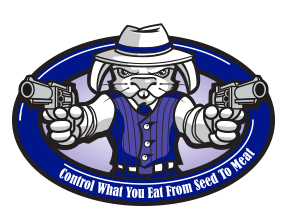Rabbit Feed Considerations
Many of us that have entered the cuniculture world (meat and fur rabbits) did so because we want to know where our food comes from. We want to make sure our livestock is treated a certain way, harvested in a humane manner, and that the animals' diet is free from substances that we would avoid ingesting ourselves. We investigate their feed, checking for quality and content suitable for our animals. Here are a few things to consider when choosing a rabbit feed for meat rabbits:
Pellet Size, Shape, and Texture
There are a number of pellets manufactured around the world, each serving different purposes and price points. Horses and goats will get a 3/8" to 1/2" diameter pellet, they are able to hold a few pellets to a handful in there mouths at a time. Rabbits, however, need a smaller pellet. They usually get 1/8 to 3/16" diameter pellets. Any larger and they will bite and waste the pellets one by one. The shape of the pellet should be cylindrical, should average 1/4" to 1/2" long, any shorter and it may break too easy. When examining the pellet, snap a few in half, if they snap quick and break clean without a lot of crumbling, it's a good pellet. If it crumbles quickly and grinds to powder easily, the pellet is poorly milled and will be wasted by rabbits and human handling.
Fat, Fiber, and Protein Percentage
Rabbits don't really make good use of protein if it's greater than 18%. On the flip side, a pellet that's less than 15%, isn't going to do them much good either. The sweet spot is between 16-18% protein. I like feeding a high fat pellet to my bunnies, my favorite feed is 16% protein, 3.3% fat. My rabbit's do very well on it. High fiber is a must! These critters groom themselves constantly and all that hair they lick off has to go somewhere! And that somewhere is their directional track. You can free feed Timothy hay along side your pellets if you want to give them the best fiber. Or, you can get high fiber pellets. You want to aim for 20% or so (minimum 18%).
Intensity of breeding program
If our plan is to breed the bunnies 2-3 times a year, we don't need to free feed high protein, high fat pellets. Those does on a lax schedule will do just fine on 16% protein, 1.5% fat... We still want the fiber up though. If we increase the intensity of the breeding program we'll need to increase the quality of the pellets, and the serving size.
Ingredients
There are organic and natural feeds out there, its noble to feed these... but expensive. In less expensive feed there are many more additives that cause questioning. Do your research on the contents, look up their purpose and their affect. Remember, rabbit feed companies want to produce a quality product that will keep buyers happy and secure repeat business. Look for the brand's with the best reputation, check them out as best you can.
Conclusion
Rabbit pellets are a nice, convenient way to feed a large herd, or, even a small one. Keep your eye on quality and content, texture and so on. If you have to switch feeds, don't do it abruptly, gradually mix the new pellets with the old, increasing the amount of new with each serving. Watch your rabbits' health and happiness, watch their manure for changes.
http://hostilehare.com/product-category/cages/
Be sure to check us out on Facebook, Instagram, Twitter, Tumblr




